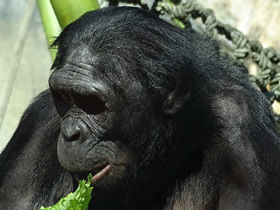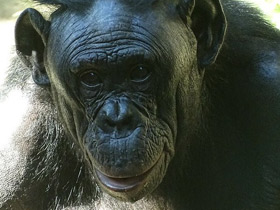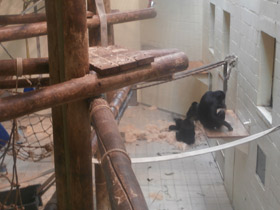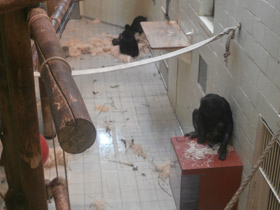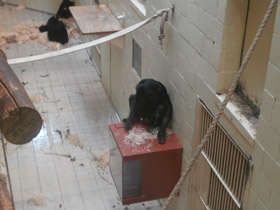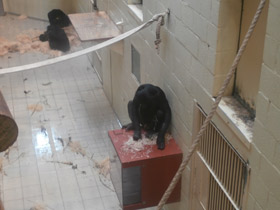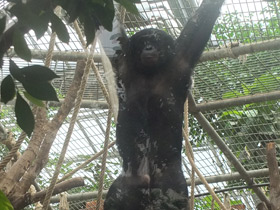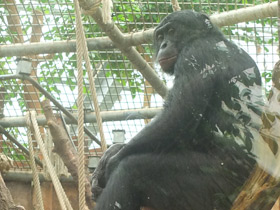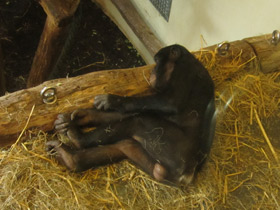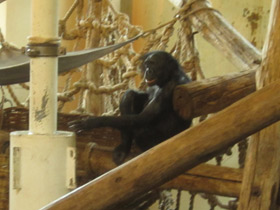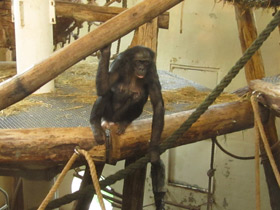The bonobo (/bəˈnoʊboʊ, ˈbɒnəboʊ/; Pan paniscus), the pygmy chimpanzee (less often the dwarf chimpanzee or gracile chimpanzee)
Bonobo видео
The bonobo (/bəˈnoʊboʊ, ˈbɒnəboʊ/; Pan paniscus), also historically called the pygmy chimpanzee (less often the dwarf chimpanzee or gracile chimpanzee), is an endangered great ape and one of the two species making up the genus Pan (the other being the common chimpanzee, Pan troglodytes). While bonobos are, today, recognized as a distinct species in their own right, they were initially thought to be a subspecies of Pan troglodytes, due to the physical similarities between the two species. Taxonomically, the members of the chimpanzee/bonobo subtribe Panina—composed entirely by the genus Pan—are collectively termed panins.
Taxonomy
The bonobo was first recognised as a distinct taxon in 1928 by German anatomist Ernst Schwarz, based on a skull in the Tervuren Museum in Belgium which had previously been classified as a juvenile chimpanzee (Pan troglodytes). Schwarz published his findings in 1929, classifying the bonobo as a subspecies of chimpanzee, Pan satyrus paniscus. In 1933, American anatomist Harold Coolidge elevated it to species status. Major behavioural differences between bonobos and chimpanzees were first discussed in detail by Tratz and Heck in the early 1950s. Unaware of any taxonomic distinction with the common chimpanzee, American psychologist and primatologist Robert Yerkes had already noticed an unexpected major behavioural difference in the 1920s.
Bonobos and chimpanzees are the two species which make up the genus Pan, and are the closest living relatives to humans (Homo sapiens).
According to studies published in 2017 by researchers at The George Washington University, bonobos, along with common chimpanzees, split from the human line about 8 million years ago; moreover, bonobos split from the common chimpanzee line about 2 million years ago.
Nonetheless, the exact timing of the Pan–Homo last common ancestor is contentious, but DNA comparison suggests continual interbreeding between ancestral Pan and Homo groups, post-divergence, until about 4 million years ago. DNA evidence suggests the bonobo and common chimpanzee species diverged approximately 890,000–860,000 years ago due to separation of these two populations possibly due to acidification and the spread of savannas at this time. Currently, these two species are separated by the Congo River, which had existed well before the divergence date, though ancestral Pan may have dispersed across the river using corridors which no longer exist. The first Pan fossils were reported in 2005 from the Middle Pleistocene (after the bonobo–chimpanzee split) of Kenya, alongside early Homo fossils.
According to A. Zihlman, bonobo body proportions closely resemble those of Australopithecus, leading evolutionary biologist Jeremy Griffith to suggest that bonobos may be a living example of our distant human ancestors. According to Australian anthropologists Gary Clark and Maciej Henneberg, human ancestors went through a bonobo-like phase featuring reduced aggression and associated anatomical changes, exemplified in Ardipithecus ramidus.
The first official publication of the sequencing and assembly of the bonobo genome was released in June 2012. The genome of a female bonobo from Leipzig Zoo was deposited with the International Nucleotide Sequence Database Collaboration (DDBJ/EMBL/GenBank) under the EMBL accession number AJFE01000000 after a previous analysis by the National Human Genome Research Institute confirmed that the bonobo genome is about 0.4% divergent from the chimpanzee genome.
Pan troglodytes and Pan paniscus
The other species in the genus Pan is the common chimpanzee (Pan troglodytes).
Most scientists consider Pan troglodytes and Pan paniscus to be the closest living relatives of humans. Genetic evidence suggests that humans and Pan troglodytes shared a common ancestor 6 million years ago, after the branch that gave rise to modern gorillas split off.
Pan paniscus diverged from Pan troglodytes about 1,500,000 years ago, when part of the ancestral Pan troglodytes population crossed the Congo River and settled in isolation on the south bank. The range of Pan paniscus is limited to lowland rainforests, including the savannah border forests of southwest Africa, where the Democratic Republic of Congo is now located. Pan troglodytes are also rainforest dwellers, but their range is much wider and their habitats are more diverse and include montane forests, seasonally arid forests and areas on the forest-savannah border, where their population density is very low.
The closest relatives of the individual
Both species have body structures adapted to life in trees. Their arms are longer than their legs, their toes are considerably longer than those of humans and their shoulder girdle is very mobile. These and other skeletal and muscular features allow them to hang from branches, climb vines and tree trunks, and move deftly in the tree canopy, using both arms and legs. Pan troglodytes and Pan paniscus feed mainly in trees, and at night they sleep in nests made of cut and broken branches. But these apes move mainly on the ground, and move on four limbs, relying on the bent finger joints of the hands (a method of movement, typical also for gorillas.) Their bodies have a number of devices for such movement, e.g. the radial bone of the forelimbs at the junction with the wrist bones has a special ridge, which does not allow the wrist to bend under the weight of the body.
Pan paniscus is also called "pygmy chimpanzee", but this is incorrect. They are indeed thinner than Pan troglodytes and their skulls are slightly different in shape, but Pan paniscus weighs no less than at least the smallest of the Pan troglodytes subspecies. Both species can stand upright on their two legs and often do so to get food or climb somewhere, but their movement on their hind legs seems rather clumsy compared to that of humans.
Pan troglodytes and Pan paniscus have a brain volume of 300-400 cc - the absolute value is quite high and so is the relative (in relation to body mass). Both species do well in the laboratory and, after intensive training (or if given ample opportunity to learn on their own), are able to communicate using symbols. In the wild, however, these monkeys communicate using a series of visual and vocal signals, but these have no symbolic meaning.
Pan troglodytes and Pan paniscus are excellent at predicting and manipulating the behaviour of other primates, whether their relatives or humans studying their behaviour. Some zoologists believe this is possible because these apes understand that other primates can also have some desire and mental capacity, i.e. that Pan troglodytes have human-like thinking abilities. However, this is still a matter of debate.
Males of Pan troglodytes and Pan paniscus are 10-20% heavier than females and relatively stronger; their tusks, which are their main weapons, are also significantly larger than those of females. Otherwise, males and females have similar body proportions.
From an early age, females periodically have swollen skin around the genitals. At first it is not regular and may last several weeks, but as the female matures, she has a regular menstrual cycle of about 35 days in Pan troglodytes and 40 days in Pan paniscus, and the swelling of the skin lasts between 12 and 20 days and occurs in the middle of each cycle. This indicates that the female is in heat, at which time she is very interested in males, often approaching them and initiating sexual contact. In the wild, Pan troglodytes usually give birth for the first time at around 13 years of age. The young develop very slowly and require constant care from their mother until they are 4 years old (she may even nurse them during this time), with birth intervals of 5-6 years between cubs.
Compared to other primates, male Pan troglodytes and Pan paniscus have very large testicles relative to their body weight and are capable of intensive mating. Males reach adult size at 16 years of age, but may reach sexual maturity earlier.
Pan paniscus
Widespread in Central Africa and the Democratic Republic of Congo, between the Congo River and Kasai, only in humid tropical forests, below 1,500 m above sea level. Body length of Pan paniscus: males 73-83 cm, females 70-76 cm, weight of males about 40 kg, weight of females about 30 kg.
Their physique is lighter than that of Pan troglodytes: narrower chest, longer limbs and shallower teeth. The face of Pan paniscus is completely black, with hair protruding from the sides of the head; a white "tail tuft" is retained on adult animals.
Reproduction: gestation 230-240 days.
Longevity: unknown.
Conservation status: the species is endangered.
Peculiarities of nutrition
Pan troglodytes and Pan paniscus are usually active from dawn to dusk; in the equatorial forest they are awake for 12-13 hours, and at least half of this time is spent feeding. Both species feed mainly on fruit and other fruits, but also on leaves, seeds, flowers, bark, stem cores and other plant parts. Pan troglodytes use about 20 plant species daily and about 300 per year for food. In their habitats, the availability of fruit varies greatly at different times of the year. Sometimes the monkeys have to make do with the fruits of the only plant species available in large quantities. Pan troglodytes eat leaves throughout the year, but in greater quantities in seasons when fruits and berries are scarce. Pan paniscus appear to feed on plant stems and cores more frequently than Pan troglodytes and there is more fruit in their habitats at all times of the year; these differences have important implications for the social structure of the populations of these species.
Pan troglodytes and Pan paniscus also eat some animal foods, such as insects (especially termites) and meat of various vertebrates; in Pan troglodytes, feeding on animal foods may occupy up to 5% of feeding time. Pan troglodytes hunt more frequently than Pan paniscus, and their prey is more diverse; they hunt monkeys, pigs, forest antelope and various small mammals. Pan troglodytes tend to hunt in groups, more often males than females. The most common prey of Pan paniscus are small forest antelopes, and they hunt more individually than in groups.
Feeding is predominantly an individual process, but in Pan troglodytes this does not apply to the process of eating meat. Sometimes males fight over prey immediately after the hunt is over, and higher-ranking males may take food from lower-ranking monkeys. However, begging for food and sharing it among community members is also quite common. Pan troglodytes that possess prey may passively allow other monkeys to take food (share it with them), or they may actively distribute pieces of meat themselves. In Pan troglodytes, prey are most often possessed by males and shared mostly with other males, especially their allies and grooming partners.
Social behaviour
Pan troglodytes and Pan paniscus communities are of variable composition (merging and dissociating). All individuals are part of an alliance of 15-20 animals with some form of social bond between them, although there is unconfirmed evidence that some females may be members of two neighbouring communities at the same time. Members of an association treat each other more or less amicably, but relationships between associations are mostly hostile, and in Pan troglodytes more so than in Pan paniscus.
Individuals belonging to the same community move and forage often, joining together in smaller groups whose size and composition may vary, all members of the community rarely (if ever) meeting together. Group size depends largely on the availability of food, especially fruit. When fruit is abundant, the number of monkeys in groups increases and they tend to gather in large fruit trees, such as giant fig trees, but when fruit is scarce, group size decreases, presumably to reduce the stress of food competition.
Average group size is slightly larger in Pan paniscus (6-15 animals) than in Pan troglodytes (3-10), with Pan paniscus having less variation in group size because the food supply in its habitat is subject to less variation.
Males of Pan troglodytes are more sociable than females, which together with their young are often kept apart from the group. In Pan paniscus, the difference in sociality between the sexes is not as pronounced. Male Pan troglodytes tend to move around more than females and use almost the entire area of their group. Females with dependent young limit their activity mainly to restricted areas in the centre of this territory, although sex differences in territory use depend on habitat.
Male Pan troglodytes and Pan paniscus remain in their home communities throughout their lives, while females often move to neighbouring communities before breeding. Adult females also sometimes change communities, but this is relatively rare. Upon entering a new community and attempting to establish herself in the new territory, the female often encounters aggression from resident females, at which point she is dependent on the males, as only they can protect her from this violence. The aggressiveness of resident Pan paniscus females is not as strong as that of Pan troglodytes, so newly arrived females often try to establish social bonds with some of them, which will help them to gain the tolerance of other members of the group in the future.
There are significant differences between the social relationships of Pan troglodytes and Pan paniscus. The Pan troglodytes community is based on dominance-subordination social relationships between males, leading to hierarchical relationships, although in multi-male communities this may not be as evident. Competition for dominance can be intense. However, friendly relationships exist between males. Males are more likely to groom and groom each other than females, and females are more likely to groom each other. Reconciliation after conflicts is also more common among males than females. Some males form alliances against other males, very important in the struggle for high rank, and the alpha male may owe his high position to the support of other males. Females, on the other hand, do not form strong bonds with each other or with males. Some females may dominate others, but they do not form hierarchical relationships. All Pan troglodytes males dominate all females.
Facial mimicry is better developed in great apes than in any other animal. The facial expressions of Pan troglodytes are particularly sophisticated and complex, and are used to convey a wide variety of social signals.
Unlike Pan troglodytes, Pan paniscus females group together and form strong social bonds with each other, regardless of the degree of relatedness. Sometimes females even form alliances against males and may force them to display subordinate behaviour, and at feeding times, males are more likely to concede primacy to females than to attempt to occupy feeding sites or seize food items.
Females often support their adult offspring during conflicts with other males and can influence their position in the hierarchy; as for female Pan troglodytes, in nature they play no role in the males' struggle for dominance. Male Pan paniscus also regularly groom each other, and grooming is more common in male than in female pairs, but they never form alliances like male Pan troglodytes.
When groups from two neighbouring communities meet, Pan troglodytes tend to behave excitedly and often threaten or chase each other, but if one group has many more monkeys, the other may withdraw quietly. Sometimes males will patrol the boundaries of their territories or even raid their neighbours.
While patrolling, they will be on the lookout for Pan troglodytes in the neighbouring area and generally behave quietly and cautiously. If their search is successful, their reactions depend mainly on the number of monkeys in the group encountered: they retreat silently or even flee if there are fewer than their neighbours, or slightly more, but attack if their numbers greatly exceed those of their rivals.
Attacks can be ferocious and deadly; male Pan troglodytes have been known to kill adult and juvenile males, young and even non-fertile adult females.
When groups of Pan paniscus from neighbouring communities meet, they also threaten each other and may harass. However, these encounters are sometimes peaceful - which is not characteristic of Pan troglodytes - and do not end in attacks.
The mating behaviour of Pan troglodytes is very complex and variable. Females in oestrus often mate several times with many or all males in their community, often even with immature males.
Mating with a large number of males complicates paternity determination and perhaps gives females some security against infanticide by males.
However, when oestrus is nearing completion, and ovulation (which usually occurs 1-3 days before the swelling of the skin around the genitalia ceases) is more likely, high-ranking males sometimes begin to accompany females and attempt to prevent them from mating with other males.
Attempts to monopolise mating involve considerable aggression, mainly directed at the females themselves. Mating success correlates with male rank, and high-ranking males are likely to have advantages and be able to impregnate more females.
Pregnancy lasts about 7.5 months. Once the female becomes pregnant, she stops cycling for 4 years, or even longer, if the offspring survive.
Use of implements
Pan troglodytes use a variety of implements: broomsticks, leaf sponges, twigs used to extract marrow from bones, and sticks and stones used as hammers and anvils.
Two types of food (social insects and fruits) usually require the use of utensils, although different populations use them differently. Most social insects have strong defences (venom), which can be dealt with using sticks or soft stalks.
Pan troglodytes make smooth, sturdy sticks 60-70 cm long (long enough to reach stray ants), drop them into an open nest, wait for ants to crawl up them, and then bring the insects to their mouths before they can sting.
To achieve the desired size and shape, the monkeys bite a blade of grass and insert it into the termite mound: the "soldiers" bite into the grass stem and remain there long enough for the Pan troglodytes to pull them out and eat them. The sticks are also used to widen the holes in the trunks, which are necessary to reach the termites or wood ants.
Another type of food for which eating tools are used are fruits with hard shells, which are too hard for Pan troglodytes to bite into. Sticks and stones weighing up to 1.5 kg are used to break the peel (or rind) of these fruits, which are sometimes thrown onto stone platforms that serve as anvils. Rounded depressions are often found in the centre of these platforms, indicating that the Pan troglodytes have been using them for a long time (centuries).
But the tools are not only used for feeding. Adult males throw sticks or stones weighing up to 4 kg or more during threatening demonstrations. A case of using a throwing projectile during a hunt has also been recorded: a male hit an adult pig from a distance of five metres and frightened it so much that it fled and allowed him to grab the piglet.
Young Pan troglodytes have to watch their conspecifics for years, learning and practising to master the use of certain tools, especially the hammer and anvil. Different populations use them differently: these are the most striking differences transmitted by social learning (the so-called "cultural traditions" in Pan troglodytes). Pan paniscus also use implements, but not as diversely and not as often.
Pan paniscus females remain in oestrus longer than Pan troglodytes females. They continue to show oestrus-like behaviour even during gestation, and the skin around their genitalia swells again a year after the birth of the young. Therefore, the sexual behaviour of Pan paniscus females is less related to conception than that of Pan troglodytes, and this may explain the fact that neither attempts at female hoarding nor infanticide are observed in Pan paniscus. Sexual behaviour is observed more frequently in Pan paniscus than in Pan troglodytes and serves several social functions. Genital rubbing and copulation are common at the time of reconciliation after conflicts and during begging for food.
It is uncertain whether we will find answers to the still unresolved questions about the behaviour of Pan troglodytes and Pan paniscus, as the future is extremely uncertain for both species. Much of their range remains intact, but most is threatened by destruction due to logging, conversion of agricultural land and other forms of human intervention. Habitat destruction and hunting are particularly fearsome for Pan troglodytes and Pan paniscus, as they are characterised by very low reproductive rates and population densities. The survival of these species in the wild will depend on continued intensive conservation efforts and, above all, on solving the problems that lead to habitat destruction and incessant hunting.

















